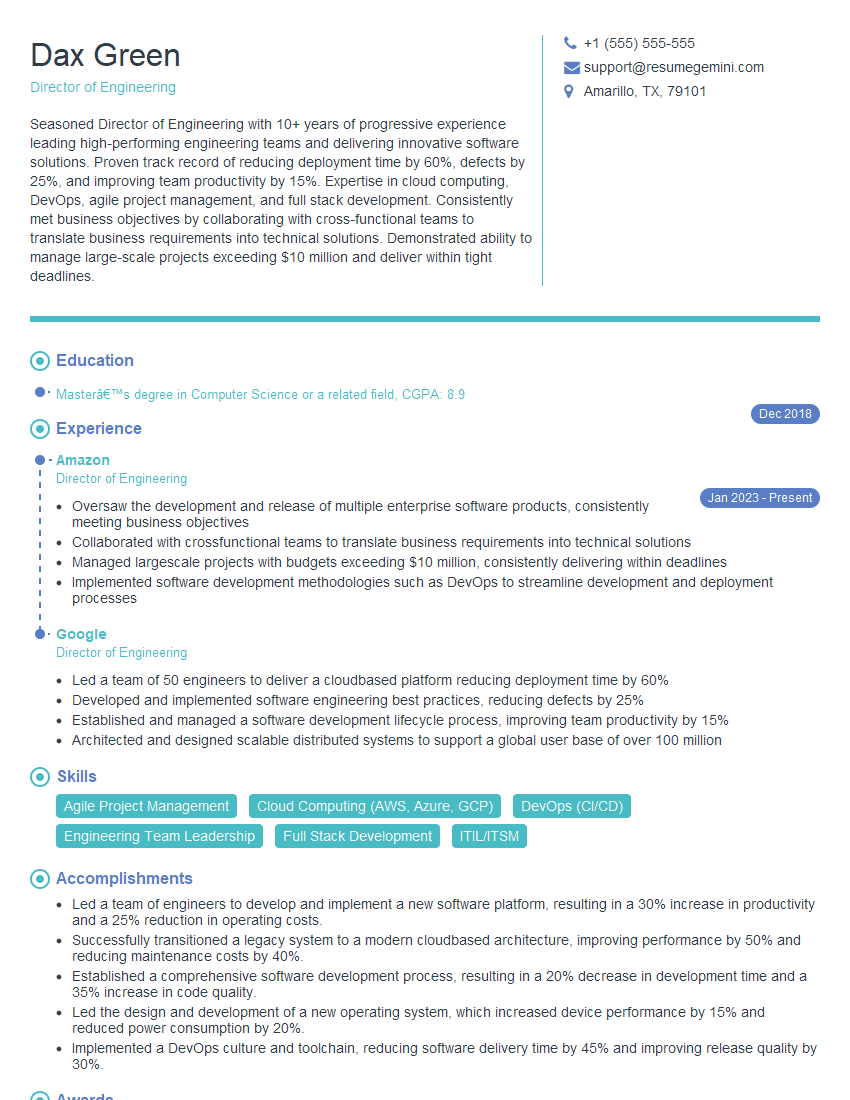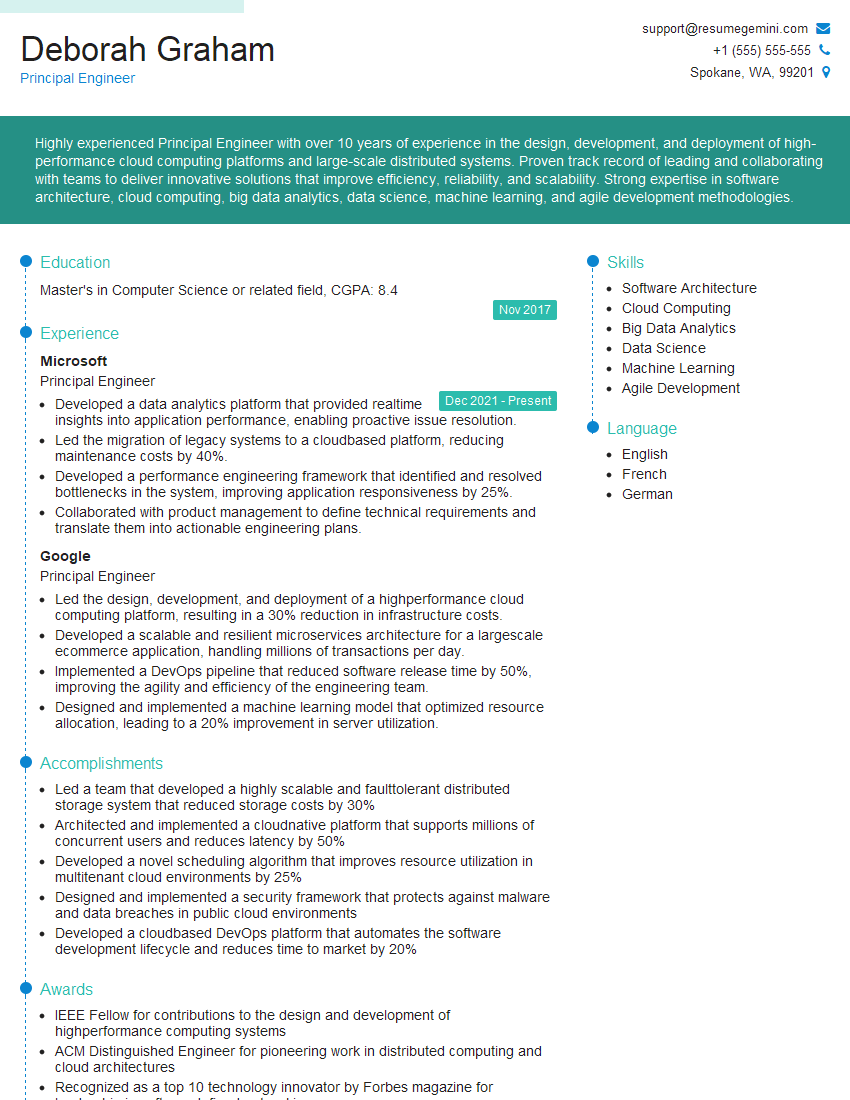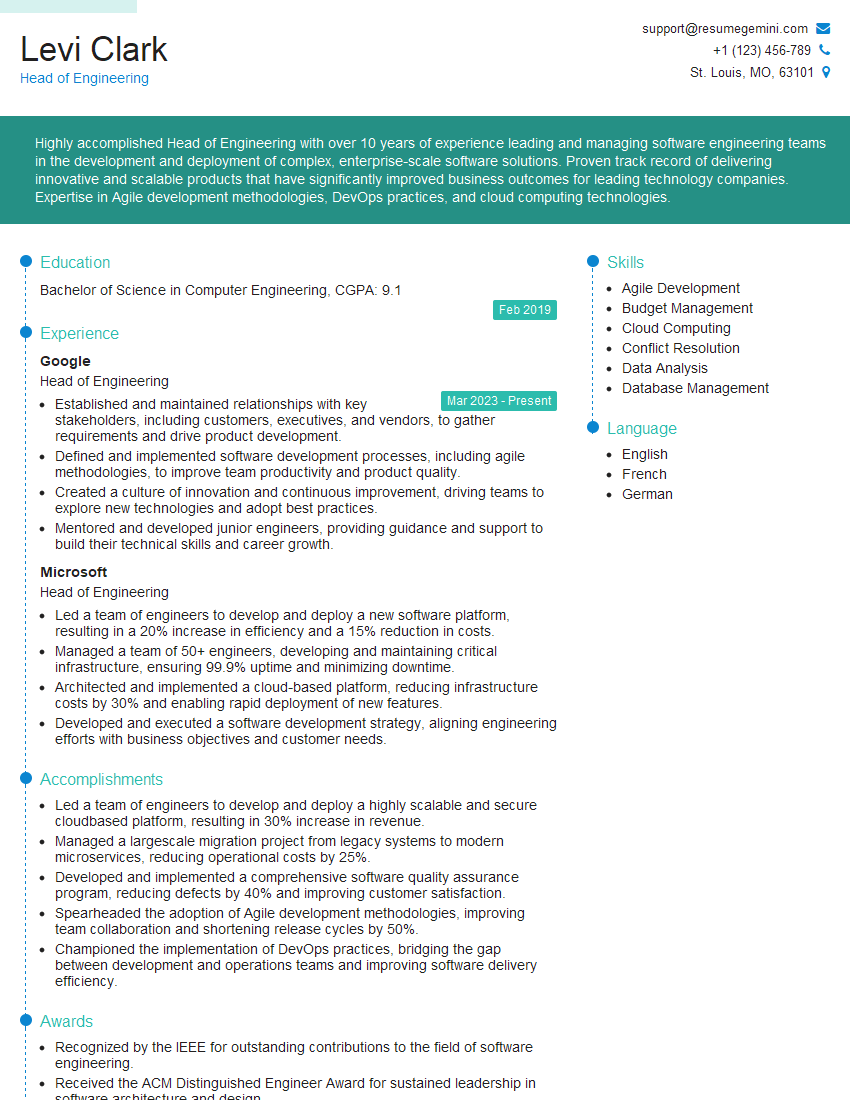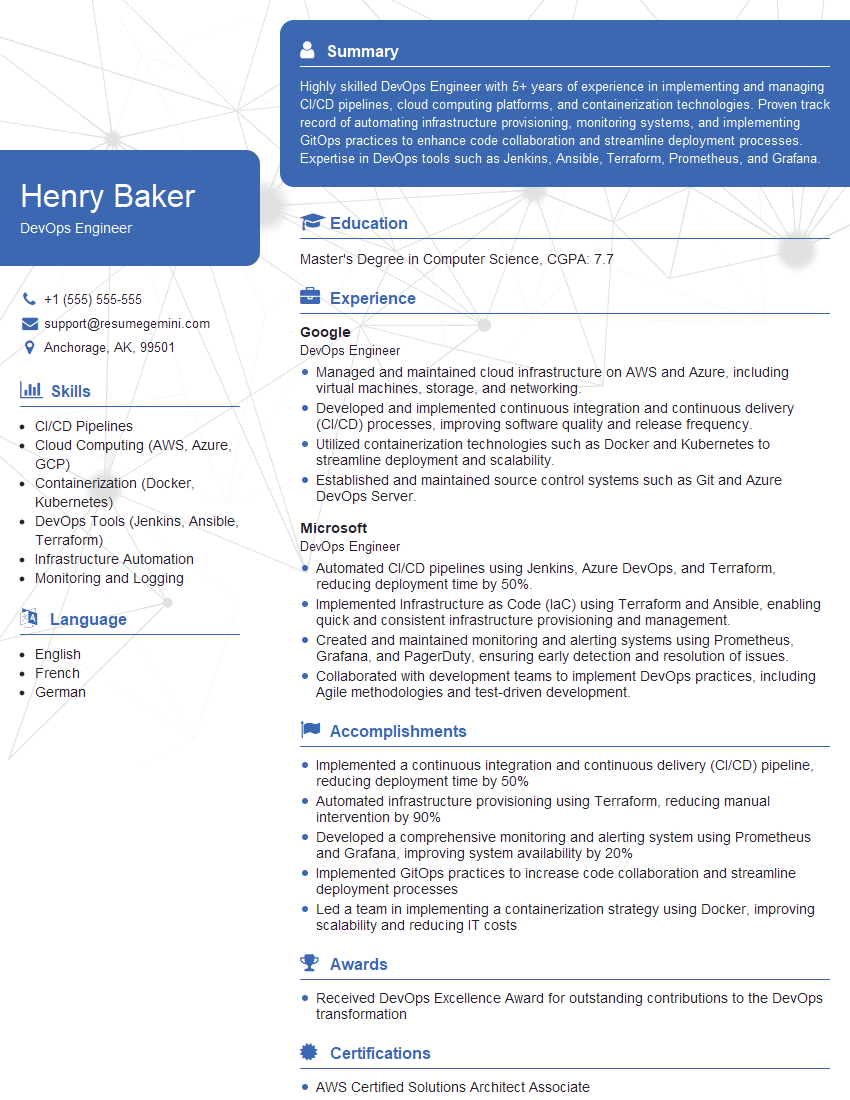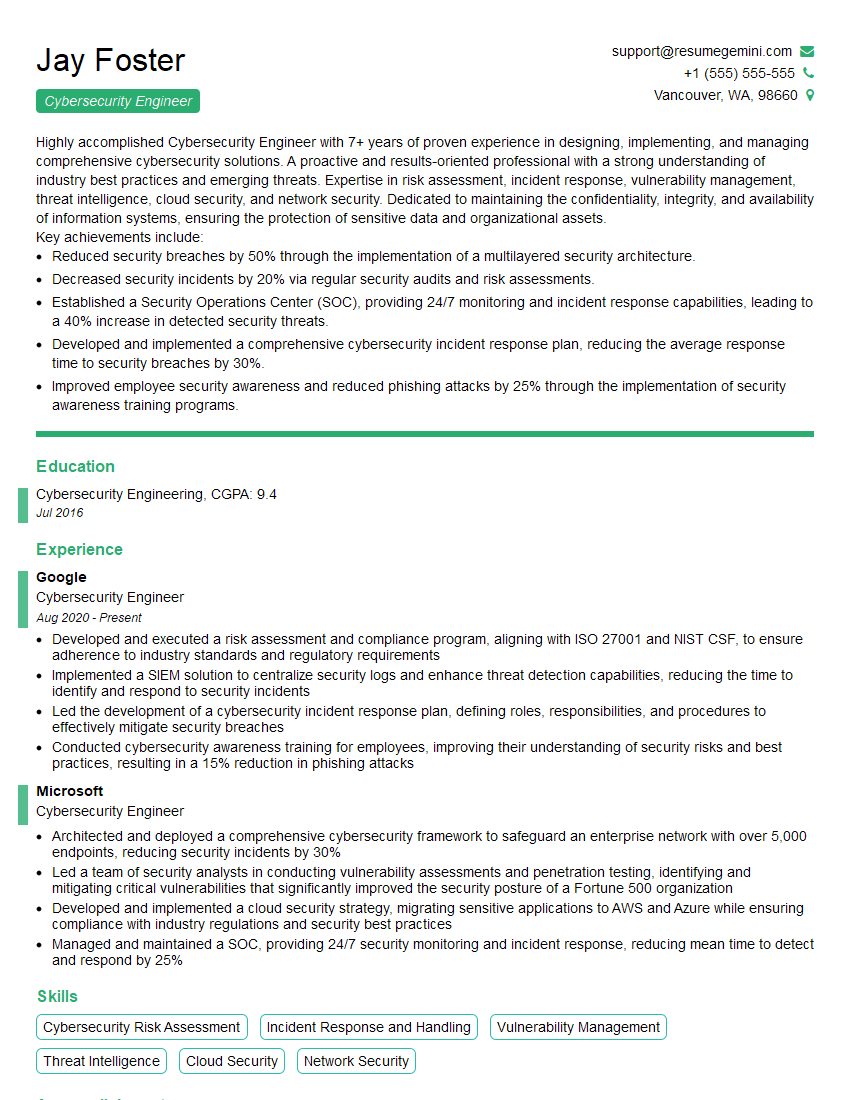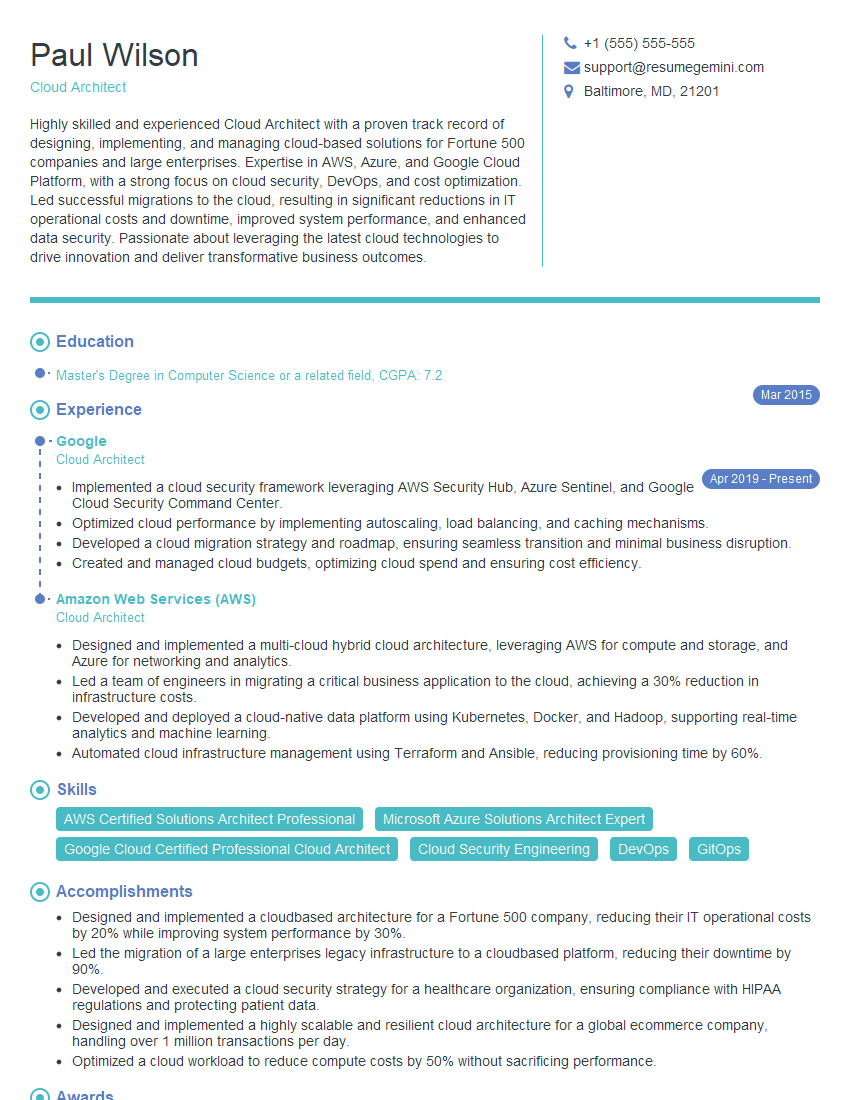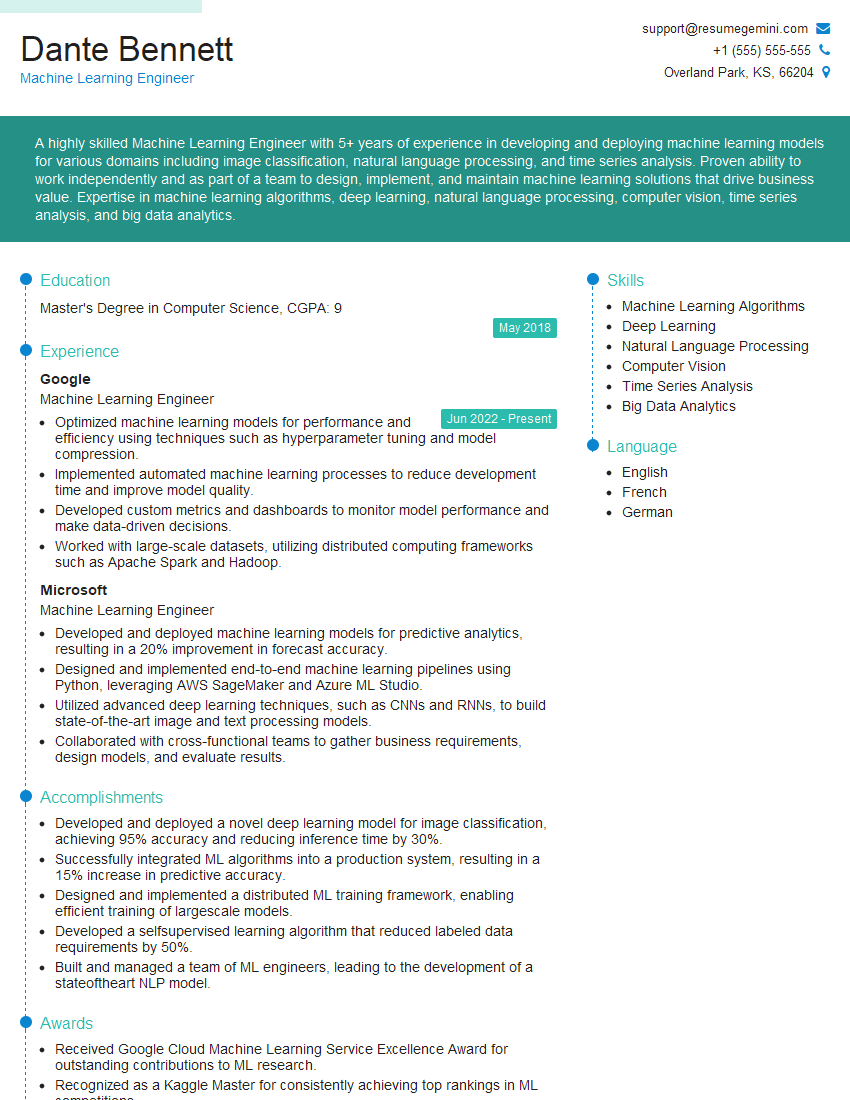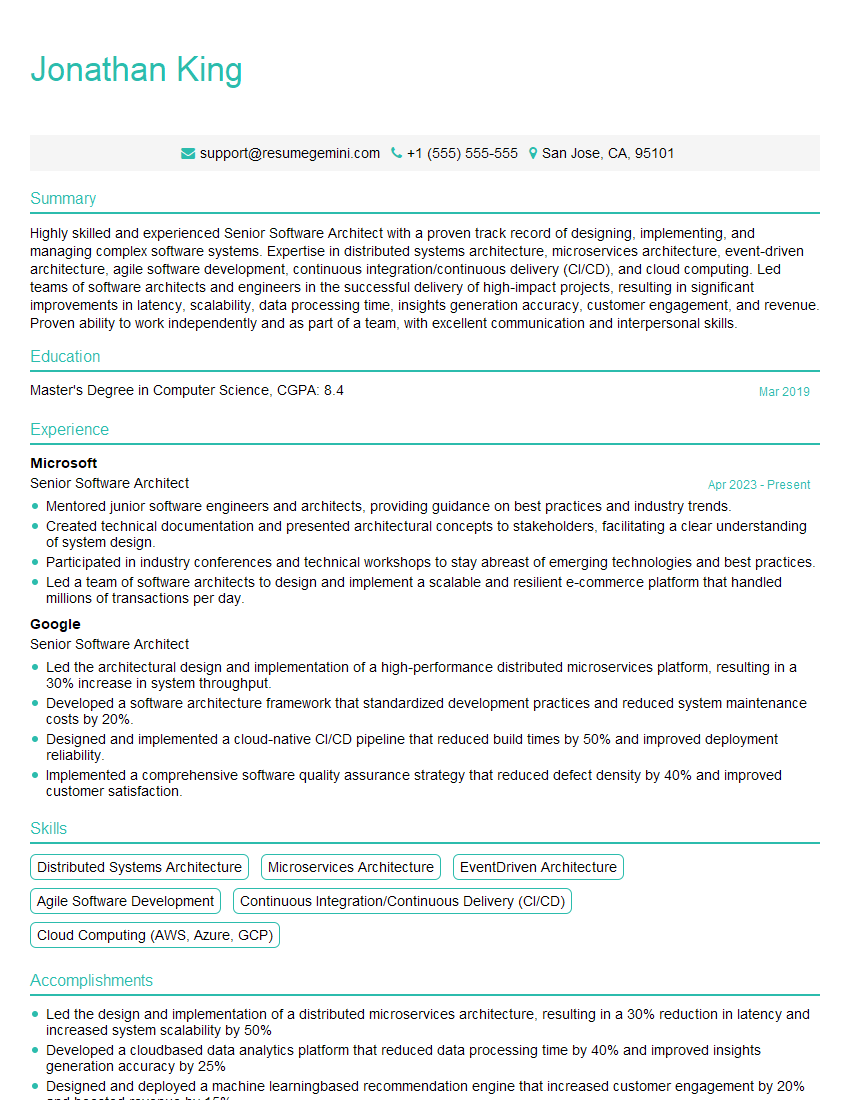The right preparation can turn an interview into an opportunity to showcase your expertise. This guide to Advanced proficiency in multiple programming languages interview questions is your ultimate resource, providing key insights and tips to help you ace your responses and stand out as a top candidate.
Questions Asked in Advanced proficiency in multiple programming languages Interview
Q 1. Explain the difference between pass-by-value and pass-by-reference.
Pass-by-value and pass-by-reference are two fundamental ways functions handle arguments in programming. Pass-by-value creates a copy of the argument’s value, which is then passed to the function. Any changes made to the argument within the function do not affect the original variable. Think of it like photocopying a document – you can make changes to the copy without altering the original. Pass-by-reference, on the other hand, passes the memory address of the argument to the function. This means the function directly works with the original variable. Any modifications within the function directly affect the original variable. This is like sharing a single document – any edits made are reflected immediately for everyone.
Example (C++):
// Pass-by-valuevoid passByValue(int x) { x = 10; }int main() { int a = 5; passByValue(a); // a remains 5 return 0;}
// Pass-by-referencevoid passByReference(int &x) { x = 10; }int main() { int a = 5; passByReference(a); // a becomes 10 return 0;}
The choice between these methods depends on the specific needs of your program. Pass-by-value is generally safer as it prevents unintended side effects, but it can be less efficient for large data structures. Pass-by-reference is more efficient for large objects but requires careful handling to avoid accidental modifications.
Q 2. Describe your experience with different programming paradigms (e.g., procedural, object-oriented, functional).
I have extensive experience working with various programming paradigms. Procedural programming, the oldest paradigm, structures code around procedures or functions. It’s straightforward and efficient for smaller projects, but can become unwieldy for large, complex systems. I’ve used C in several embedded systems projects, taking advantage of its procedural nature for direct hardware control.
Object-oriented programming (OOP) organizes code around objects that encapsulate data and methods. This improves code reusability, maintainability, and scalability. Java and C# are languages where I’ve extensively used OOP principles to build robust and modular applications, like a large-scale inventory management system. Design patterns are critical here, promoting best practices and reducing complexity.
Functional programming focuses on immutability and the application of functions to data. Languages like Haskell and Clojure emphasize this paradigm. I’ve used functional programming techniques in data processing pipelines using Python, leveraging libraries like Pandas for efficient data manipulation, where immutability prevents unintended side effects.
My experience spans these paradigms; often, I find projects benefit from a hybrid approach, leveraging the strengths of each as needed for a particular task or component within the system. For example, a project might have a core object-oriented architecture but employ functional programming techniques for specific data transformations.
Q 3. Compare and contrast the strengths and weaknesses of Java and Python.
Java and Python are both popular programming languages, but with distinct strengths and weaknesses. Java is a statically-typed, compiled language known for its performance, robustness, and platform independence (‘write once, run anywhere’). It excels in building large-scale enterprise applications and Android apps. The strong typing helps catch errors at compile time, leading to fewer runtime surprises. However, Java’s verbosity and steeper learning curve can be drawbacks for rapid prototyping or smaller projects.
Python is a dynamically-typed, interpreted language favored for its readability, ease of use, and extensive libraries for data science, machine learning, and web development. Its rapid development capabilities make it perfect for prototyping and scripting tasks. The dynamic typing can lead to runtime errors if not carefully handled, and its performance can be slower than Java’s for computationally intensive tasks.
In essence: choose Java for performance and reliability in large-scale applications, and choose Python for rapid development and ease of use in areas like data science and scripting. The best choice depends entirely on the project’s requirements and constraints.
Q 4. How would you handle concurrency issues in a multi-threaded application?
Concurrency issues in multi-threaded applications arise from multiple threads accessing and modifying shared resources simultaneously. This can lead to race conditions, deadlocks, and other unpredictable behavior. To handle these, several strategies are crucial:
- Synchronization mechanisms: These control access to shared resources, preventing race conditions. Common techniques include mutexes (mutual exclusion locks), semaphores, and monitors. Mutexes ensure that only one thread can access a critical section at a time. Semaphores allow a specified number of threads to access a resource concurrently. Monitors encapsulate shared resources and their access methods to simplify synchronization.
- Thread-safe data structures: Using data structures designed to handle concurrent access safely is essential. For example, using concurrent collections in Java (e.g.,
ConcurrentHashMap) eliminates the need for manual synchronization for many common operations. - Atomic operations: These operations are guaranteed to be executed as a single, uninterruptible unit. This ensures data consistency even in highly concurrent environments.
- Proper thread management: Careful design of thread lifecycles and communication between threads is crucial. Techniques like thread pools and bounded queues can help manage resources and prevent excessive thread creation.
- Deadlock avoidance: Deadlocks occur when two or more threads are blocked indefinitely, waiting for each other to release resources. Careful resource allocation and ordering, and using techniques like deadlock detection and recovery, are key to preventing deadlocks.
Choosing the appropriate strategy depends on the specific context. For simple cases, mutexes might suffice. More complex scenarios might require more sophisticated mechanisms like semaphores or monitors. Thorough testing and profiling are crucial to identify and address concurrency issues effectively.
Q 5. Explain your understanding of design patterns (e.g., Singleton, Factory, Observer).
Design patterns are reusable solutions to common software design problems. They provide a blueprint for structuring code, promoting better organization, readability, and maintainability. Let’s look at a few examples:
- Singleton: Ensures that only one instance of a class is created. This is useful for managing resources like database connections or logging services. Consider a configuration manager where only one instance should exist to maintain consistency across the application. Implementing this pattern involves a private constructor and a static method to retrieve the single instance.
- Factory: Provides an interface for creating objects without specifying their concrete classes. This allows for flexible object creation and promotes loose coupling. Imagine a system that creates different types of vehicles (cars, trucks, motorcycles). A factory pattern could abstract the creation process, allowing you to add new vehicle types without changing client code that uses the factory.
- Observer (or Publish-Subscribe): Defines a one-to-many dependency between objects, where one object (subject) notifies its dependents (observers) of state changes. This is crucial for building event-driven systems, such as GUI updates or data stream processing. For instance, in a stock market application, when a stock price changes, the observer pattern would notify all subscribed clients of this change.
Understanding and applying design patterns significantly improves the quality and maintainability of software. They are not strict rules but rather proven solutions that can be adapted to specific needs.
Q 6. Describe your approach to debugging complex software issues.
Debugging complex software issues requires a systematic and methodical approach. I typically follow these steps:
- Reproduce the problem: The first step is to reliably reproduce the bug. This often involves creating a minimal reproducible example.
- Gather information: Collect logs, error messages, and relevant data points. This involves examining stack traces, analyzing logs for patterns, and understanding the system’s state during the error.
- Isolate the source: Use debugging tools such as debuggers, profilers, and logging frameworks to narrow down the location of the problem. Step-by-step execution in a debugger is invaluable here.
- Formulate hypotheses: Based on the gathered information, develop hypotheses about the root cause of the bug. These should be testable.
- Test hypotheses: Design and execute tests to validate or invalidate your hypotheses. This often involves modifying code, rerunning tests, and observing the effects.
- Implement a fix: Once the root cause is identified and confirmed, implement a fix. This should be thoroughly tested to ensure it doesn’t introduce new problems.
- Document the fix: Record the steps taken, the cause, and the solution to prevent future occurrences of the same issue.
Effective debugging is about more than just finding the bug; it’s about understanding the underlying system and its behavior. Tools like debuggers and profilers are invaluable, but a solid understanding of the codebase and the problem domain are equally important. I often find that breaking down complex problems into smaller, manageable pieces simplifies the debugging process.
Q 7. What are your preferred methods for version control and collaboration?
For version control, I primarily use Git. It’s the industry standard, offering excellent branching, merging, and collaboration features. I’m comfortable using various Git workflows, including Gitflow and GitHub Flow, tailoring my approach to the specific project’s needs. For collaboration, I rely heavily on platforms like GitHub and GitLab. These provide features for code review, issue tracking, and continuous integration/continuous deployment (CI/CD).
My workflow typically involves frequent commits with clear and concise messages, making it easy to track changes and collaborate with team members. I actively participate in code reviews, providing and receiving feedback to ensure code quality and consistency. The use of pull requests (or merge requests) ensures a robust code review process before merging changes into the main branch. In larger projects, employing a well-defined branching strategy, such as Gitflow, can help manage different features and releases effectively.
Q 8. How would you optimize a slow-performing database query?
Optimizing a slow database query involves a systematic approach, focusing on identifying bottlenecks and applying appropriate solutions. Think of it like troubleshooting a car – you need to diagnose the problem before fixing it.
Analyze the Query Plan: The first step is to examine the query execution plan provided by your database system (e.g.,
EXPLAIN PLANin Oracle,EXPLAINin MySQL). This plan reveals how the database intends to execute the query, highlighting potential inefficiencies like full table scans instead of index lookups.Indexing: If the query plan shows full table scans, adding indexes on frequently queried columns can dramatically improve performance. Indexes are like a book’s index – they allow the database to quickly locate specific data without scanning the entire table. For instance, if you frequently query by customer ID, an index on the
customer_idcolumn would be highly beneficial.Query Rewriting: Sometimes, the query itself can be inefficient. You might need to rewrite the query using more efficient SQL constructs. For example, replacing
NOT INwithNOT EXISTScan often lead to significant performance gains. Consider using joins effectively, avoiding unnecessary subqueries, and optimizingWHEREclause conditions.Data Normalization: Poorly designed database schemas can lead to performance issues. Normalizing your database ensures data redundancy is minimized, resulting in smaller tables and faster queries. Consider the impact of joins and the number of tables accessed.
Caching: Caching frequently accessed data in memory (e.g., using Redis or Memcached) can significantly reduce the load on the database. This is like keeping frequently used items within easy reach instead of going to the warehouse every time.
Hardware Optimization: In some cases, the database server itself might be underpowered. Upgrading the server’s RAM, CPU, or storage can lead to improved performance. This is the equivalent of upgrading your car’s engine.
Database Tuning: Database systems often have configuration parameters that can be tweaked for optimal performance. This requires a good understanding of the database’s architecture and internal workings. For example, adjusting buffer pool size or connection pool size can greatly improve query performance.
In a real-world scenario, I once optimized a slow-running report query by adding an index to a date column, reducing the query execution time from over an hour to under a minute. The key was systematically analyzing the query plan and identifying the bottleneck.
Q 9. Explain your experience with different database systems (e.g., SQL, NoSQL).
My experience spans both SQL and NoSQL databases. I’ve worked extensively with relational databases like MySQL, PostgreSQL, and Oracle, which are ideal for structured data with well-defined relationships. I’m also proficient with NoSQL databases such as MongoDB and Cassandra, which are better suited for unstructured or semi-structured data and scenarios requiring high scalability and availability.
SQL Databases: With SQL, I’m comfortable designing relational schemas, writing complex queries using joins, subqueries, and aggregate functions, and optimizing queries for performance using indexing and query tuning techniques. I’ve used stored procedures, triggers, and views to encapsulate business logic and improve data integrity.
NoSQL Databases: In NoSQL environments, I’ve worked with document databases (MongoDB) for flexible data modeling and key-value stores (like Redis) for caching. I understand the trade-offs between data consistency and availability in distributed NoSQL systems. For example, I’ve used MongoDB for handling large volumes of user data where schema flexibility was crucial, and Redis for caching frequently accessed session data to improve application responsiveness.
The choice between SQL and NoSQL depends entirely on the specific application requirements. A project requiring ACID properties (Atomicity, Consistency, Isolation, Durability) and complex relationships would benefit from SQL, while a project emphasizing scalability and flexibility might lean towards NoSQL.
Q 10. Describe your experience with cloud platforms (e.g., AWS, Azure, GCP).
I have significant experience with AWS, Azure, and GCP, focusing on deploying and managing applications in cloud environments. My expertise includes:
AWS: Experience with EC2 (virtual servers), S3 (object storage), RDS (managed relational databases), Lambda (serverless computing), and other AWS services. I’ve deployed and managed applications using Docker containers on ECS (Elastic Container Service) and Kubernetes on EKS (Elastic Kubernetes Service).
Azure: Proficiency in using Azure Virtual Machines, Blob Storage, Azure SQL Database, Azure Functions, and Azure App Service. I’ve worked with Azure DevOps for CI/CD pipelines.
GCP: Experience with Compute Engine, Cloud Storage, Cloud SQL, Cloud Functions, and Kubernetes Engine (GKE). I’ve implemented monitoring and logging using Google Cloud Monitoring and Logging.
In a recent project, we migrated a legacy on-premise application to AWS. This involved designing the architecture, migrating the database, configuring security, and setting up CI/CD pipelines. We utilized EC2 instances, RDS, S3, and other AWS services to build a robust and scalable cloud-based solution.
Q 11. How would you design a RESTful API?
Designing a RESTful API involves adhering to architectural constraints and best practices to ensure a well-structured and maintainable system. It’s all about creating a clear and consistent interface for interacting with your application’s data and functionality.
Resource-Based URLs: URLs should represent resources (e.g.,
/users,/products/123). Each resource has a unique identifier.HTTP Methods: Use standard HTTP verbs (GET, POST, PUT, DELETE) to represent the actions performed on resources (GET for retrieving, POST for creating, PUT for updating, DELETE for removing).
Statelessness: Each request should be self-contained, not relying on context from previous requests. The server should not store any client-specific data between requests.
Cacheability: Responses should indicate whether they can be cached, improving performance and efficiency.
Uniform Interface: Maintain a consistent interface across all resources. Use standard response codes and formats (e.g., JSON).
Client-Server Architecture: The client and server should be independent and loosely coupled.
Layered System: The API should be layered to allow for greater flexibility and maintainability.
For example, a GET /users request would return a list of users, while a POST /users request would create a new user. Error handling should also be consistent, using standard HTTP status codes to indicate success or failure.
Q 12. What are your preferred testing methodologies (e.g., unit testing, integration testing)?
My preferred testing methodologies are a combination of unit, integration, and end-to-end testing. Each plays a crucial role in ensuring the software’s quality and reliability.
Unit Testing: I use unit tests to verify the functionality of individual components or modules in isolation. This allows for quick identification and resolution of bugs at an early stage. I typically use frameworks like JUnit (Java), pytest (Python), or similar depending on the project’s programming language.
Integration Testing: Integration tests check how different components interact with each other. This helps identify integration-related issues that might not be apparent during unit testing. I often use mocking frameworks to simulate dependencies and isolate the interactions being tested.
End-to-End Testing: End-to-end tests verify the entire application flow from start to finish, simulating real-world user scenarios. These tests are essential for catching issues that span multiple components or layers of the system.
I believe in test-driven development (TDD) where possible, writing tests before writing the actual code. This helps clarify requirements and ensures the code is designed with testability in mind. I also use code coverage tools to measure the effectiveness of my testing and identify areas needing improvement.
Q 13. Explain your experience with different software development methodologies (e.g., Agile, Waterfall).
I have experience with both Agile and Waterfall methodologies. The choice depends heavily on the project’s size, complexity, and requirements.
Agile: I’ve extensively used Scrum and Kanban, focusing on iterative development, frequent feedback, and close collaboration with stakeholders. Agile is great for projects with evolving requirements or those needing rapid iteration and adaptation. I’ve used tools like Jira and Trello for task management and project tracking.
Waterfall: In projects with well-defined requirements and less need for flexibility, a Waterfall approach can be appropriate. This methodology emphasizes a sequential flow of phases, from requirements gathering to deployment. While less flexible than Agile, it can be effective for projects with limited risk of changing requirements.
In practice, I often find a hybrid approach, combining elements of both Agile and Waterfall, is most effective. For example, I might use an Agile approach for the development of core features while employing a more structured Waterfall approach for critical infrastructure elements.
Q 14. How would you handle a conflict between two developers?
Handling conflicts between developers requires a calm, professional, and collaborative approach. The goal is to find a solution that’s mutually agreeable and beneficial to the project.
Facilitate Open Communication: The first step is to encourage open and honest communication between the developers involved. Create a safe space for them to express their concerns and perspectives.
Identify the Root Cause: Determine the underlying cause of the conflict. Is it a misunderstanding, a disagreement on technical approaches, or a personality clash?
Find Common Ground: Focus on finding common ground and areas of agreement. Emphasize the shared goals of the project.
Mediate if Necessary: If the developers are unable to resolve the conflict on their own, I would act as a mediator, guiding them towards a solution. This might involve suggesting alternative approaches, compromising, or escalating the issue to a higher level of management if necessary.
Document the Resolution: Once a resolution is reached, document the outcome to avoid similar conflicts in the future. This might involve updating team guidelines or processes.
In one instance, I mediated a conflict between two developers regarding the best way to implement a particular feature. By facilitating a discussion and encouraging them to consider each other’s viewpoints, we reached a compromise that incorporated the best aspects of both their approaches. The key was to focus on the problem, not the personalities involved.
Q 15. What is your understanding of data structures and algorithms?
Data structures are ways of organizing and storing data in a computer so that it can be used efficiently. Algorithms are sets of step-by-step instructions that a computer follows to solve a problem or perform a specific task. They work together; a well-chosen data structure can significantly improve the efficiency of an algorithm. For instance, searching for a specific element is much faster in a sorted array (using binary search) than in an unsorted linked list (requiring a linear search). Understanding both is crucial for writing efficient and scalable software.
- Examples of Data Structures: Arrays, linked lists, stacks, queues, trees, graphs, hash tables.
- Examples of Algorithms: Sorting (merge sort, quicksort), searching (binary search, breadth-first search), graph traversal (DFS, BFS), dynamic programming.
Choosing the right data structure and algorithm depends heavily on the specific problem. For example, if you need to frequently insert and delete elements at arbitrary positions, a linked list might be better than an array. If you need to quickly search for elements, a hash table might be the best choice.
Career Expert Tips:
- Ace those interviews! Prepare effectively by reviewing the Top 50 Most Common Interview Questions on ResumeGemini.
- Navigate your job search with confidence! Explore a wide range of Career Tips on ResumeGemini. Learn about common challenges and recommendations to overcome them.
- Craft the perfect resume! Master the Art of Resume Writing with ResumeGemini’s guide. Showcase your unique qualifications and achievements effectively.
- Don’t miss out on holiday savings! Build your dream resume with ResumeGemini’s ATS optimized templates.
Q 16. How would you implement a specific algorithm in your preferred language?
My preferred language is Python, known for its readability and extensive libraries. Let’s implement a breadth-first search (BFS) algorithm on a graph represented as an adjacency list. BFS is excellent for finding the shortest path in unweighted graphs.
import collections
def bfs(graph, start):
visited = set()
queue = collections.deque([start])
visited.add(start)
while queue:
vertex = queue.popleft()
print(vertex, end=" ")
for neighbor in graph[vertex]:
if neighbor not in visited:
visited.add(neighbor)
queue.append(neighbor)
graph = {
'A': ['B', 'C'],
'B': ['D', 'E'],
'C': ['F'],
'D': [],
'E': ['F'],
'F': []
}
bfs(graph, 'A') # Output: A B C D E F
This code uses a queue (collections.deque) to maintain the order of nodes to visit. It keeps track of visited nodes to avoid cycles. The algorithm systematically explores the graph level by level, ensuring that nodes closer to the starting node are visited first.
Q 17. Describe your experience with different data serialization formats (e.g., JSON, XML).
I have extensive experience with JSON and XML, two widely used data serialization formats. JSON (JavaScript Object Notation) is lightweight and human-readable, making it ideal for web applications and APIs where data needs to be easily exchanged between client and server. XML (Extensible Markup Language) offers more structure and flexibility, particularly useful for complex data hierarchies and scenarios requiring schema validation.
- JSON: Often used for representing structured data like configuration files, APIs responses, and data storage in NoSQL databases. Its simple key-value pair structure is easy to parse and generate.
- XML: Used in applications requiring rigorous data validation and highly structured data, such as configuration files, document storage, and exchanging data between different systems. XML schemas ensure data integrity and consistency.
The choice between JSON and XML depends on the specific needs of the project. JSON is generally preferred for its simplicity and efficiency when dealing with relatively simple data, whereas XML is more suitable for complex, structured data where data integrity and validation are paramount.
Q 18. How would you design a scalable system?
Designing a scalable system requires careful consideration of several factors. The key is to anticipate growth and design the system to handle increasing load gracefully. This involves:
- Horizontal Scaling: Adding more servers to distribute the workload. This is often more cost-effective than vertical scaling.
- Load Balancing: Distributing requests across multiple servers to prevent any single server from becoming overloaded.
- Database Optimization: Choosing the right database technology and optimizing database queries to ensure fast response times.
- Caching: Storing frequently accessed data in memory to reduce the load on the database and improve response times.
- Microservices Architecture: Breaking down the system into smaller, independent services that can be scaled independently.
For example, a social media platform might use a microservices architecture with separate services for user profiles, newsfeeds, and messaging. Each service can be scaled independently based on its specific needs.
Q 19. How would you handle exception handling in your code?
Exception handling is crucial for writing robust and reliable software. It involves anticipating potential errors and gracefully handling them to prevent application crashes. In Python, we use try...except blocks:
try:
result = 10 / 0
except ZeroDivisionError:
print("Error: Division by zero")
except Exception as e:
print(f"An unexpected error occurred: {e}")
This code attempts a division by zero. The try block contains the code that might raise an exception. The except blocks catch specific exceptions or general exceptions. Using specific exception handlers is good practice because it allows for more precise error handling. Generic except blocks should be used sparingly as they can mask underlying issues.
Q 20. Explain your understanding of security best practices.
Security best practices are fundamental to developing reliable software. They involve protecting the application from various threats, such as:
- Input Validation: Sanitizing all user inputs to prevent injection attacks (SQL injection, cross-site scripting).
- Authentication and Authorization: Securely verifying user identities and controlling access to resources.
- Data Encryption: Protecting sensitive data both in transit and at rest using appropriate encryption techniques.
- Secure Coding Practices: Avoiding common vulnerabilities like buffer overflows and race conditions.
- Regular Security Audits and Penetration Testing: Identifying and addressing security weaknesses proactively.
For example, always validate user input before using it in database queries to prevent SQL injection. Use strong passwords and implement multi-factor authentication wherever appropriate.
Q 21. Describe your experience with different software architectures (e.g., microservices, monolithic).
I’ve worked with both monolithic and microservices architectures. Monolithic architectures consist of a single, large application. They’re simpler to develop and deploy initially, but can become difficult to maintain and scale as they grow larger. Microservices break down the application into smaller, independent services that communicate with each other. This improves scalability, maintainability, and fault tolerance.
- Monolithic Architecture: Easier to develop and deploy initially, but harder to scale and maintain as it grows. Changes to one part of the application can affect the entire system.
- Microservices Architecture: More complex to develop and deploy, but offers better scalability, maintainability, and fault tolerance. Changes to one service typically don’t affect others.
The choice between these architectures depends on the project’s size, complexity, and scalability requirements. Small projects might benefit from a monolithic architecture, while large, complex projects often benefit from a microservices approach.
Q 22. What is your experience with code refactoring?
Code refactoring is the process of restructuring existing computer code—changing the factoring—without changing its external behavior. It’s akin to renovating a house: you’re improving the internal structure and layout (making it more efficient, maintainable, and readable) without altering its external appearance (the functionality it provides).
My experience encompasses refactoring in various languages like Java, Python, and C++. I’ve worked on projects where refactoring was crucial for improving performance, enhancing readability, and reducing technical debt. For example, I recently refactored a legacy Java application that used monolithic classes. By applying design patterns like the Strategy pattern and refactoring methods into smaller, more focused units, I improved code maintainability and reduced the risk of introducing bugs during future modifications. I frequently use automated refactoring tools provided by IDEs (Integrated Development Environments) like IntelliJ IDEA and Eclipse to streamline the process and ensure accuracy.
- Improving Readability: Replacing long, complex methods with smaller, well-named methods that perform single tasks.
- Enhancing Maintainability: Extracting common code into reusable functions or classes.
- Boosting Performance: Optimizing algorithms and data structures to improve efficiency.
I always prioritize testing during refactoring to ensure that functionality remains unchanged. This typically involves a combination of unit tests and integration tests, deployed and run frequently.
Q 23. How do you approach learning new programming languages?
Learning a new programming language for me is a structured process that blends theory with hands-on practice. It’s like learning a new instrument – you need to understand the music theory (syntax, semantics, core concepts) and then practice playing (coding small projects, solving problems).
My approach typically involves:
- Structured Learning: I start with the fundamentals – syntax, data types, control flow. I often use online courses (like Coursera or Udemy) or books to build a solid foundation.
- Hands-on Projects: I immediately start applying what I’ve learned by building small projects. This could range from simple command-line applications to more complex web applications, depending on the language.
- Practical Problem Solving: I tackle coding challenges on platforms like HackerRank or LeetCode. This helps reinforce my understanding and exposes me to different problem-solving techniques.
- Community Engagement: Engaging with online communities, forums, and documentation is key to learning best practices and resolving challenges.
For example, when learning Go, I started with a simple web server project. This allowed me to quickly grasp the language’s concurrency features and its approach to error handling. This practical approach helps accelerate the learning process and fosters a deeper understanding of the language’s strengths and weaknesses.
Q 24. What is your experience with different build tools (e.g., Maven, Gradle)?
I have extensive experience with various build tools, primarily Maven and Gradle. Both are powerful tools for managing dependencies, compiling code, running tests, and packaging applications. However, they differ in their approach and capabilities.
Maven: Maven uses a convention-over-configuration approach, relying heavily on a standardized project structure and XML-based configuration files (pom.xml). This ensures consistency and simplifies project setup. Its maturity and widespread adoption in Java projects are its main strengths. However, its XML-based configuration can become cumbersome for complex projects.
Gradle: Gradle employs a more flexible, Groovy-based configuration system, offering more control and customization options. It supports various languages beyond Java and scales well to large projects. Its dynamic nature and support for parallel execution make it significantly faster than Maven in many cases. I prefer Gradle for larger projects needing a high degree of customization and flexibility.
In my experience, selecting the right build tool depends on the project’s size, complexity, and the team’s familiarity with the tool. I can adapt seamlessly to either, and frequently use both depending on the project’s technology stack.
Q 25. Explain your experience with containerization technologies (e.g., Docker, Kubernetes).
Containerization technologies like Docker and Kubernetes have revolutionized software deployment and management. Docker provides a lightweight, portable way to package applications and their dependencies into containers, ensuring consistent execution across different environments. Kubernetes, on the other hand, is an orchestration platform for managing and scaling containerized applications across a cluster of machines. It automates deployment, scaling, and management, making it ideal for complex, microservice-based architectures.
I’ve used Docker extensively to create reproducible build environments and simplify application deployment. For instance, I built Docker images for a microservice architecture using Docker Compose to manage multiple containers. This greatly simplified the development, testing, and deployment process.
My experience with Kubernetes includes deploying and managing applications using Kubernetes manifests (YAML files) and managing deployments, services, and pods. I understand concepts like namespaces, deployments, replicasets, and services. I’ve worked with various Kubernetes resources and used kubectl to manage clusters. In one project, we used Kubernetes to automate the deployment of a complex, multi-tiered application, ensuring high availability and scalability. This experience showed me the immense benefits of container orchestration in managing large-scale applications.
Q 26. How do you stay up-to-date with the latest technologies?
Staying current with rapidly evolving technologies is essential. I employ a multi-pronged approach:
- Following Industry Blogs and Publications: I regularly read tech blogs and publications (e.g., InfoQ, Medium) focusing on my areas of interest.
- Attending Conferences and Webinars: Conferences offer opportunities to learn about cutting-edge technologies and network with industry experts.
- Participating in Online Communities: Engaging in discussions on forums like Stack Overflow and Reddit keeps me up-to-date with common issues and innovative solutions.
- Experimenting with New Technologies: I dedicate time to exploring new tools and technologies through personal projects.
- Reading Books and Documentation: Technical books and official documentation are invaluable resources for in-depth understanding.
This blend of passive and active learning ensures I stay informed about the latest trends and best practices.
Q 27. Describe a challenging technical problem you solved. What was your approach?
One challenging problem I solved involved optimizing a high-traffic web application that experienced significant performance bottlenecks during peak hours. The application was built using a monolithic architecture, making it difficult to pinpoint the exact source of the slowdown.
My approach was systematic:
- Profiling and Monitoring: I started by using profiling tools to identify performance bottlenecks. This revealed that database queries were the primary source of the slowdown.
- Database Optimization: I optimized database queries by adding indexes, refactoring queries to be more efficient, and using caching mechanisms.
- Load Balancing and Caching: I implemented a load balancer to distribute traffic across multiple servers. I also added a caching layer to reduce the load on the database.
- Code Refactoring: I refactored sections of the code that were inefficient, removing redundant operations and improving algorithm efficiency.
- A/B Testing: Before fully deploying changes, I performed A/B testing to ensure the modifications improved performance without introducing new issues.
Through this multi-faceted approach, we were able to significantly reduce response times and improve the overall performance of the application during peak hours. The key was a combination of thorough analysis, targeted optimization, and careful testing.
Q 28. Explain your understanding of SOLID principles.
The SOLID principles are five design principles intended to make software designs more understandable, flexible, and maintainable. They’re essential for building robust and scalable applications. Think of them as guidelines for constructing a well-organized, easily-modified building.
- Single Responsibility Principle (SRP): A class should have only one reason to change. This means each class should have a single, well-defined responsibility. For example, a
Userclass should only handle user-related logic, not database interactions. - Open/Closed Principle (OCP): Software entities (classes, modules, functions, etc.) should be open for extension, but closed for modification. This principle advocates for using interfaces and abstract classes to allow adding new functionality without changing existing code.
- Liskov Substitution Principle (LSP): Subtypes should be substitutable for their base types without altering the correctness of the program. This ensures that derived classes behave consistently with their base classes.
- Interface Segregation Principle (ISP): Clients should not be forced to depend upon interfaces they don’t use. Instead of one large interface, it’s better to have several small interfaces that are more specific.
- Dependency Inversion Principle (DIP): High-level modules should not depend on low-level modules. Both should depend on abstractions. Abstractions should not depend on details. Details should depend upon abstractions. This principle promotes loose coupling by using interfaces and abstraction layers.
By adhering to SOLID principles, developers can build more maintainable, flexible, and testable software systems, significantly reducing the cost and effort of future modifications and enhancements.
Key Topics to Learn for Advanced Proficiency in Multiple Programming Languages Interview
- Data Structures and Algorithms: Mastering advanced data structures (e.g., graphs, trees, heaps) and algorithms (e.g., dynamic programming, graph traversal) is crucial for tackling complex problems efficiently. Understand their time and space complexities and choose the optimal solution based on problem constraints.
- Object-Oriented Programming (OOP) Principles: Demonstrate a deep understanding of encapsulation, inheritance, polymorphism, and abstraction. Be prepared to discuss design patterns and their applications in solving real-world problems. Consider examples across multiple languages to showcase your comparative understanding.
- Concurrency and Parallelism: Explain concepts like threads, processes, synchronization, and deadlocks. Discuss your experience with concurrent programming paradigms and libraries in different languages (e.g., multithreading in Java, asyncio in Python). Prepare to discuss challenges and solutions related to concurrent programming.
- Database Management Systems (DBMS): Show proficiency in SQL and NoSQL databases. Be ready to discuss database design, optimization techniques (e.g., indexing, query optimization), and transaction management. Highlight your experience with different database systems and their specific features.
- Software Design Principles and Architectural Patterns: Discuss your experience with different software architectural patterns (e.g., microservices, MVC) and design principles (e.g., SOLID principles). Be prepared to explain design choices and trade-offs.
- Testing and Debugging: Showcase your understanding of various testing methodologies (unit, integration, system testing) and debugging techniques. Demonstrate your ability to write clean, testable code and effectively identify and resolve bugs.
- Version Control Systems (e.g., Git): Demonstrate a strong understanding of Git workflows (e.g., branching, merging, rebasing) and best practices for collaborative software development.
- Language-Specific Advanced Features: For each language you claim proficiency in, be ready to discuss advanced features, libraries, and frameworks. This showcases a deep, nuanced understanding beyond basic syntax.
Next Steps
Mastering advanced proficiency in multiple programming languages significantly enhances your career prospects, opening doors to highly sought-after roles and higher earning potential. An ATS-friendly resume is critical to ensuring your skills and experience are effectively communicated to potential employers. ResumeGemini is a trusted resource to help you craft a compelling and impactful resume that highlights your unique capabilities. Use ResumeGemini to build a professional resume showcasing your expertise; examples of resumes tailored to candidates with advanced proficiency in multiple programming languages are available to inspire your own creation.
Explore more articles
Users Rating of Our Blogs
Share Your Experience
We value your feedback! Please rate our content and share your thoughts (optional).
What Readers Say About Our Blog
Hi, I’m Jay, we have a few potential clients that are interested in your services, thought you might be a good fit. I’d love to talk about the details, when do you have time to talk?
Best,
Jay
Founder | CEO
